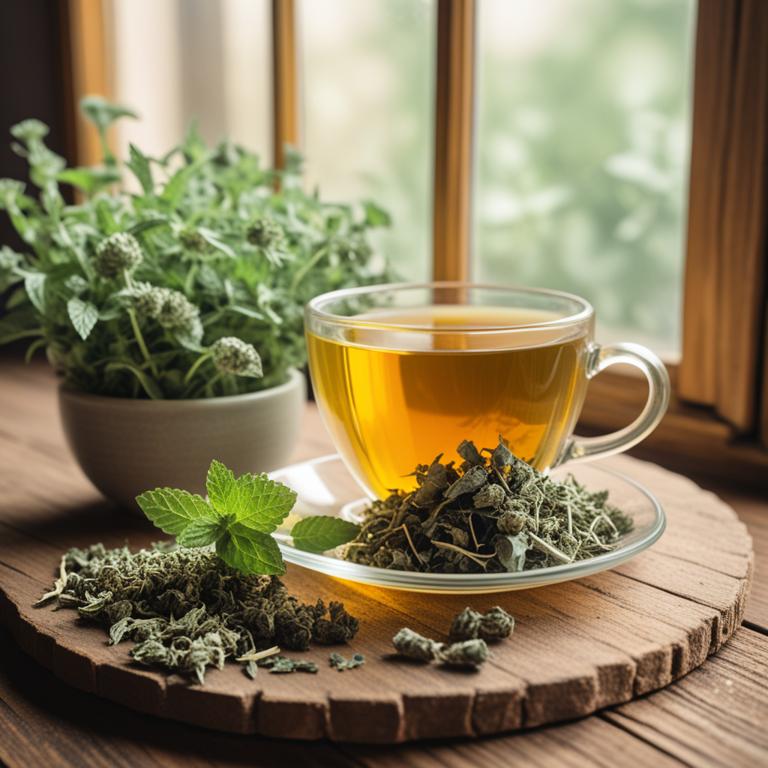9 Best Herbal Teas For Nausea

Herbal teas for nausea are a type of natural remedy made from various herbs and plants, specifically designed to alleviate and prevent nausea and vomiting.
These teas can be effective in treating nausea due to their soothing and calming properties, which help to reduce stomach upset and alleviate digestive discomfort.
Some popular herbal teas used to treat nausea include ginger tea, which has anti-inflammatory properties that help to ease stomach cramps and nausea; peppermint tea, which has a calming effect on the digestive system and can help to reduce nausea and vomiting; chamomile tea, which has a soothing and relaxing effect that can help to calm the stomach and reduce nausea; licorice root tea, which has anti-inflammatory properties that can help to soothe the stomach and reduce nausea; and lemon balm tea, which has a calming effect on the digestive system and can help to reduce nausea and vomiting.
Additionally, other herbal teas such as dandelion root tea, fennel tea, and raspberry leaf tea may also be used to treat nausea due to their ability to calm the digestive system and alleviate stomach discomfort.
Related Study
According to "Alternative therapies in health and medicine", teas for nausea such as those containing ginger, which has been found to be effective in relieving symptoms of nausea, may be a useful remedy for nausea and vomiting in the first trimester of pregnancy.
Below there's a list of the 9 best herbal teas for nausea.
Table of Contents
Also, you may be interested in...
Today Free Bonus!
The Ultimate Herb Drying Checklist
(For Long-Lasting Powerful Medicinal Effect)
How to easily dry herbs that don't mold and that keep their strong medicinal power for more than 1 year.
1. Zingiber officinale teas

Zingiber officinale teas, derived from the ginger plant, have been traditionally used to treat nausea, particularly in cases of morning sickness and chemotherapy-induced nausea.
The bioactive constituents of ginger, such as gingerols and shogaols, have anti-inflammatory and antioxidant properties that help to alleviate nausea by reducing inflammation and stabilizing the digestive system.
These compounds help to treat nausea by inhibiting the release of serotonin, a neurotransmitter that can contribute to nausea, and by soothing the stomach and intestines.
The benefits of ginger tea for treating nausea include its ease of use, natural composition, and minimal side effects, making it a popular and effective herbal remedy.
Related Study
According to "British journal of anaesthesia", Zingiber officinale teas for nausea showed a non-significant difference in reducing postoperative nausea, but collectively favoured ginger over placebo in studies for seasickness, morning sickness and chemotherapy-induced nausea.
Recipe:
- Gather 1 teaspoon of dried Zingiber officinale root, a cup of boiling water, and a strainer.
- Add the 1 teaspoon of dried root to the cup of boiling water.
- Steep for 5-7 minutes to allow the root to infuse into the water.
- Strain the tea into another cup using the strainer.
- Drink the tea as needed to help alleviate nausea.
Usage:
- Drink 1-2 cups of Zingiber officinale tea after meals and before bedtime.
- Start with 250-500 mg or 1/2 to 1 teaspoon of dried ginger root per cup.
- Gradually increase dosage to 1-2 teaspoons per cup as needed.
- Use 2-3 times a day for nausea, but not more than 3 weeks continuously.
- Combine with other nausea-relieving herbs like peppermint or lemon balm for better results.
Zingiber officinale teas can help alleviate nausea symptoms, but possible side effects may include stomach upset, diarrhea, or allergic reactions such as hives or itching in some individuals.
To use Zingiber officinale teas safely, be cautious when consuming them in large quantities, especially if you have a pre-existing stomach condition or are taking medications, and also avoid consuming them before surgery as they may increase the risk of bleeding.
Zingiber Officinale Tea on Amazon
FGO Organic Ginger Tea, 100 Count, Eco-Conscious Tea Bags, Caffeine Free, Packaging May Vary (Pack of 1)
Disclaimer: We earn a commission if you click this link and make a purchase at no additional cost to you.
2. Cinchona officinalis teas

Cinchona officinalis teas have been traditionally used to treat nausea, particularly during pregnancy and motion sickness.
The anti-inflammatory and antispasmodic properties of this herbal preparation help to alleviate nausea symptoms by reducing stomach irritation and soothing muscle spasms.
The bioactive constituents, including alkaloids such as quinine and quinidine, help to stabilize stomach acidity and calm the nervous system, contributing to their nausea-relieving effects.
By consuming Cinchona officinalis teas, individuals may experience a reduction in nausea severity and frequency, providing relief from this uncomfortable and debilitating condition.
Recipe:
- Gather 2 teaspoons of dried Cinchona officinalis bark and 1 cup of boiling water.
- Place the Cinchona bark in a heat-resistant cup or teapot.
- Pour the boiling water over the Cinchona bark.
- Let it steep for 5-7 minutes, then strain the tea into another cup.
- Drink 1-2 cups of the tea as needed for nausea relief.
Usage:
- Drink 1 cup of Cinchona officinalis tea when nausea occurs.
- Repeat as needed, up to 3 cups within 24 hours.
- For severe nausea, take 1 teaspoon of Cinchona bark powder.
- Combine powder with 1 cup of water and drink immediately.
- For prevention, drink 1 cup of Cinchona tea 30 minutes before eating.
Cinchona officinalis teas can be used to alleviate nausea, but possible side effects may include dizziness, headaches, and stomach upset due to its high quinine content.
To avoid these side effects, it is recommended to start with a low dose and gradually increase as needed, also be cautious when consuming with other medications or substances that may interact with quinine, and avoid use during pregnancy or breastfeeding.
3. Glycyrrhiza glabra teas

Glycyrrhiza glabra teas, derived from the roots of the licorice plant, have been traditionally used to treat nausea due to their anti-inflammatory and antioxidant properties.
The bioactive constituents, such as glycyrrhizin and flavonoids, help to soothe the stomach and alleviate nausea by reducing inflammation and stabilizing digestive enzymes.
This herbal preparation has been found to be beneficial in treating nausea by modulating the gut-brain axis and promoting a sense of calm and well-being.
By incorporating Glycyrrhiza glabra teas into one's diet, individuals can experience relief from nausea and other digestive issues, making it a valuable natural remedy for promoting overall health and wellness.
Related Study
According to "Mini reviews in medicinal chemistry", Glycyrrhiza glabra teas for nausea may be beneficial in managing viral respiratory infections, such as the flu and common cold, due to its ability to inhibit virus growth and produce anti-inflammatory activity.
Recipe:
- Gather 1 cup of water and 1 teaspoon of dried Glycyrrhiza glabra root.
- Heat the water in a pot until it boils.
- Add 1 teaspoon of dried Glycyrrhiza glabra root to the boiling water.
- Reduce heat and let it steep for 5-7 minutes.
- Strain the tea and serve warm. Take 1/2 cup to 1 cup as needed for nausea relief.
Usage:
- Drink 1/4 cup of Glycyrrhiza glabra tea, 2-3 times a day.
- Start with a low dosage of 250mg, 30 minutes before meals.
- Gradually increase dosage to 500mg if nausea persists.
- Continue using tea for 2-3 days or as directed by a doctor.
- Monitor nausea and adjust dosage or frequency as needed.
Glycyrrhiza glabra teas can be used to treat nausea, but potential side effects may include headaches, dizziness, and changes in blood pressure due to its high content of glycyrrhizin.
To use Glycyrrhiza glabra teas safely, it's recommended to limit consumption to 1-2 cups per day, avoid using it for extended periods, and be cautious when mixing it with other medications or health supplements, as it may interact with them.
Glycyrrhiza Glabra Tea on Amazon
Pukka Herbal Teas Licorice and Cinnamon - 20 Bags, 20 Count
Disclaimer: We earn a commission if you click this link and make a purchase at no additional cost to you.
4. Foeniculum vulgare teas

Foeniculum vulgare teas, also known as anise tea, have been traditionally used to treat nausea and its associated symptoms.
The bioactive constituents of this herbal preparation, including anethole, limonene, and estragole, possess anti-inflammatory and carminative properties, which help to alleviate nausea by soothing the stomach and reducing inflammation.
The carminative and anti-emetic properties of Foeniculum vulgare teas help to relieve nausea by preventing the buildup of gas in the digestive system and reducing the frequency and severity of nausea episodes.
Regular consumption of Foeniculum vulgare teas has been found to provide relief from nausea and its associated symptoms, making it a beneficial herbal remedy for individuals experiencing nausea.
Related Study
According to "Oxidative medicine and cellular longevity", Foeniculum vulgare teas for nausea may be beneficial due to the presence of biologically active chemical constituents that exhibit significant spasmolytic effects, which can help alleviate gastrointestinal discomfort.
Recipe:
- Gather 1 cup of fresh Foeniculum vulgare leaves or 2 teaspoons of dried leaves.
- Boil 1 cup of water in a pot.
- Add the Foeniculum vulgare leaves to the boiling water.
- Reduce heat and let it simmer for 5-7 minutes.
- Strain the tea and drink it hot or warm as needed for nausea relief.
Usage:
- Drink 1 cup of Foeniculum vulgare tea, 2-3 times daily.
- Take 1 teaspoon (5ml) of dried Foeniculum vulgare in tea.
- Start with small amounts (1 teaspoon) and adjust as needed.
- Continue for 3-5 days or until nausea subsides.
- Consult a doctor for guidance on prolonged usage.
Foeniculum vulgare teas can be an effective remedy for nausea, but possible side effects include stomach upset, diarrhea, and allergic reactions, particularly in individuals with sensitivity to anethole, a compound found in the plant.
Precautions to take when using Foeniculum vulgare teas for nausea treatment include avoiding excessive consumption, as it may exacerbate stomach issues, and being mindful of interactions with other medications, such as blood thinners and diabetes medications.
5. Mentha x piperita teas

Mentha x piperita teas, also known as peppermint tea, have been traditionally used to treat nausea and its associated symptoms.
The anti-inflammatory and antispasmodic properties of this herbal preparation help to soothe the digestive system and alleviate nausea.
The bioactive constituents, including menthol and menthone, work together to relax the muscles in the stomach and reduce inflammation, providing relief from nausea.
Drinking peppermint tea has several benefits in treating nausea, including promoting digestion, reducing symptoms of irritable bowel syndrome, and providing a natural and non-invasive treatment option.
Related Study
According to "Phytotherapy research : PTR", Mentha x piperita teas for nausea may have 5-HT antagonist activity which could help alleviate chemotherapy-induced nausea and vomiting (CINV).
Recipe:
- Gather 1 cup of fresh peppermint leaves or 1 teaspoon of dried peppermint.
- Boil 1 cup of water in a pot.
- Add the peppermint leaves or dried peppermint to the boiling water.
- Reduce heat and let it steep for 5-7 minutes.
- Strain the tea and drink 1/2 cup to 1 cup as needed for nausea relief.
Usage:
- Drink 1/2 cup of Mentha x piperita tea hot or cold.
- Take 1-2 teaspoons of fresh mint leaves per 1/2 cup of water.
- Use 2-3 times a day as needed for nausea relief.
- Take tea 30 minutes before meals or when feeling nauseous.
- Consult doctor for proper dosage and usage guidelines.
Mentha x piperita teas can be an effective herbal remedy to alleviate nausea, but it may also cause side effects such as stomach upset, diarrhea, and dizziness due to its high menthol content.
To minimize potential side effects, it is essential to start with a low dose and gradually increase as needed, and to avoid consuming Mentha x piperita teas in combination with other medications or herbal supplements that may interact with its active ingredients.
6. Ginkgo biloba teas

Ginkgo biloba teas have been used for centuries to alleviate nausea and its associated symptoms.
The anti-inflammatory and antioxidant properties of this herbal preparation help to treat nausea by soothing the digestive system and reducing inflammation in the stomach.
The bioactive constituents, including flavonoids and terpenoids, in Ginkgo biloba teas work together to calm the stomach and alleviate nausea by inhibiting the release of serotonin and other neurotransmitters that contribute to nausea.
Regular consumption of Ginkgo biloba teas can provide relief from nausea and its associated symptoms, offering a natural and effective remedy for those experiencing nausea.
Recipe:
- Gather 1 cup of water, 1 tablespoon of dried Ginkgo biloba leaves, and a tea infuser or a heat-resistant cup.
- Heat the water in a pot or kettle until it reaches 200°F (93°C).
- Place the dried Ginkgo biloba leaves in the tea infuser or directly into the heat-resistant cup.
- Pour the hot water over the Ginkgo biloba leaves and let it steep for 5-7 minutes.
- Strain the tea and discard the leaves. Drink the tea as is or add honey to taste.
Usage:
- Drink 1 cup of Ginkgo biloba tea 2-3 times a day
- Start with a low dose of 1/2 teaspoon of dried leaves per cup
- Gradually increase to 1 teaspoon per cup as needed
- Take tea 30 minutes before meals or when nausea occurs
- Consult a doctor before using Ginkgo biloba for extended periods
Ginkgo biloba teas can be used to treat nausea, but some possible side effects include stomach upset, diarrhea, and allergic reactions such as hives or itching.
To minimize potential side effects, it's recommended to start with a low dose and gradually increase it, and to avoid consuming the tea on an empty stomach or with other medications that may interact with ginkgo biloba.
Ginkgo Biloba Tea on Amazon
Tai Chi Think Sharp Energizing Tea (Ginseng Ginkgo Biloba) 12 Bags
Disclaimer: We earn a commission if you click this link and make a purchase at no additional cost to you.
7. Lavandula angustifolia teas

Lavandula angustifolia teas, derived from the lavender plant, have been traditionally used to treat nausea and its associated symptoms.
The herbal preparation's calming and anti-inflammatory properties help to soothe the digestive system and reduce nausea, making it an effective remedy for morning sickness, motion sickness, and other types of nausea.
The bioactive constituents of Lavandula angustifolia teas, including linalool and linalyl acetate, have been found to possess anti-inflammatory and antispasmodic properties that help to calm the stomach and alleviate nausea.
The benefits of using Lavandula angustifolia teas to treat nausea include reducing the frequency and severity of nausea episodes, promoting relaxation, and providing a natural and non-invasive solution to this common health issue.
Related Study
According to "Oxidative medicine and cellular longevity", Lavandula angustifolia teas may have potential benefits in alleviating nausea due to its antispasmodic properties.
Recipe:
- Gather 1 cup of fresh Lavandula angustifolia flowers or 2 teaspoons of dried flowers.
- Heat 1 cup of boiling water in a kettle or on the stove.
- Add the Lavandula angustifolia flowers to a heat-resistant cup or teapot.
- Pour the boiling water over the flowers and let it steep for 5-7 minutes.
- Strain the tea into a separate cup and drink it slowly when needed for nausea relief.
Usage:
- Drink 1 cup of Lavandula angustifolia tea 2-3 times daily as needed.
- Start with 1 teaspoon of dried herbs per cup for first week.
- Gradually increase to 2 teaspoons per cup for optimal results.
- Use tea for 3-7 days to help alleviate nausea symptoms.
- Consult a healthcare professional for proper guidance and dosage.
Lavandula angustifolia teas can be used to treat nausea, but possible side effects may include drowsiness, headaches, and allergic reactions such as skin rashes or itching.
Precautions should be taken when using Lavandula angustifolia teas to treat nausea, including avoiding it during pregnancy and breastfeeding, as well as being cautious when driving or operating heavy machinery due to its sedative properties.
Lavandula Angustifolia Tea on Amazon
Tiesta Tea - Lavender Chamomile Herbal Tea | Loose Leaf | Calming Blend with Chamomile and Lavender | Caffeine-Free Herbal | Great for Hot or Iced Brews | Resealable Bulk Pouch, 200 Cups | 8 Ounce
Disclaimer: We earn a commission if you click this link and make a purchase at no additional cost to you.
8. Piper nigrum teas

Piper nigrum teas, also known as black pepper tea, have been traditionally used to treat nausea, a common symptom associated with various health conditions.
The anti-inflammatory and carminative properties of this herbal preparation help to soothe the digestive system and alleviate nausea.
The bioactive constituents, including piperine and beta-caryophyllene, in Piper nigrum teas may help to reduce inflammation and relax the smooth muscles in the digestive tract, thereby providing relief from nausea.
By consuming Piper nigrum teas, individuals may experience a reduction in nausea symptoms and improved overall digestive health, making it a potential natural remedy for this ailment.
Related Study
According to "Clinical gastroenterology and hepatology : the official clinical practice journal of the American Gastroenterological Association", Piper nigrum teas, also known as black pepper, were found to be effective in relieving nausea due to motion sickness or pregnancy.
Recipe:
- Gather 1 tablespoon of dried Piper nigrum (black pepper) and 1 cup of water.
- Boil the water in a pot and let it cool for 1-2 minutes.
- Add the 1 tablespoon of dried Piper nigrum to the cooled water.
- Let the mixture steep for 5-7 minutes, then strain the liquid.
- Drink the Piper nigrum tea as needed for nausea relief, in small amounts (1/4 cup) at a time.
Usage:
- Drink 1 cup of Piper nigrum tea 2-3 times a day
- Start with 1 teaspoon of Piper nigrum per 8 oz water
- Gradually increase to 2 teaspoons if needed for severe nausea
- Continue treatment for 3-5 days or until nausea subsides
- Consult a healthcare professional if nausea persists or worsens
Piper nigrum teas can be an effective natural remedy to alleviate nausea, but it may also cause side effects such as stomach upset, diarrhea, and allergic reactions in some individuals.
To use Piper nigrum teas safely, it is essential to start with a low dose and gradually increase it as needed, and to avoid consuming it if you have any pre-existing digestive issues or allergies.
9. Curcuma longa teas

Curcuma longa teas, derived from the roots of the turmeric plant, have been traditionally used to treat nausea and other gastrointestinal disorders.
The anti-inflammatory and antioxidant properties of curcuma longa teas help to alleviate nausea by reducing inflammation and oxidative stress in the body.
The bioactive constituents, including curcumin, demethoxycurcumin, and bisdemethoxycurcumin, have been shown to inhibit the activity of enzymes responsible for nausea and vomiting, thereby providing relief from this ailment.
Regular consumption of curcuma longa teas has been found to be beneficial in treating nausea, particularly in cases of motion sickness, morning sickness, and chemotherapy-induced nausea.
Related Study
According to the study, Curcuma longa teas for nausea have potential due to the presence of the compound curcumin, which is a phytochemical with properties that could alleviate digestive problems.
Recipe:
- Gather 1 tsp of dried Curcuma longa root powder and 1 cup of water in a saucepan.
- Heat the water over low heat and add the Curcuma longa root powder.
- Stir well and let it simmer for 5-7 minutes to allow the powder to infuse.
- Strain the mixture into a cup and discard the solids.
- Drink the tea when it is still warm, up to 2-3 times a day as needed.
Usage:
- Drink 1 cup of Curcuma longa tea, 2-3 times a day.
- Start with 1 teaspoon of dried powder per cup of boiling water.
- Increase dosage to 1.5 teaspoons if nausea persists after 2 days.
- Use Curcuma longa tea for 3-5 days to alleviate nausea symptoms.
- Consult a healthcare professional if nausea worsens or persists.
Curcuma longa teas can be effective in treating nausea, but possible side effects may include stomach upset, diarrhea, and allergic reactions in some individuals.
To minimize side effects, it is recommended to consume Curcuma longa teas in moderation, starting with small amounts and gradually increasing the dose, and to avoid combining it with other medications or herbal preparations that may interact with its active compounds.
Curcuma Longa Tea on Amazon
Pure Ceylon Turmeric Brew - 100% Organic Ceylon Turmeric Tea Bags (40 Sachets - pack of 2 – 20 COUNT PER BOX)
Disclaimer: We earn a commission if you click this link and make a purchase at no additional cost to you.